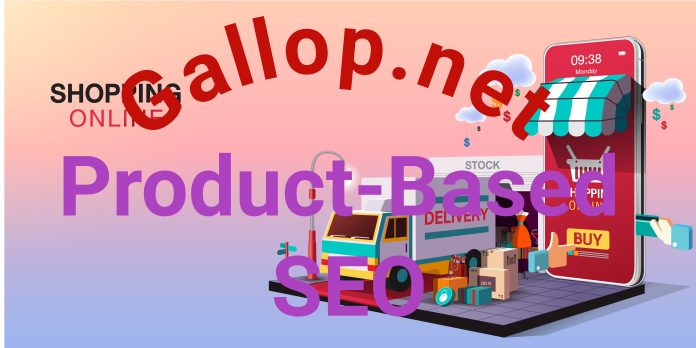Product-Based SEO for Online Stores
Mastering Product-Based SEO for Online Stores
Product-based SEO for online stores is essential for driving organic traffic to individual product listings.
In today’s digital marketplace, standing out among countless online stores is a challenge that requires strategic planning.
The vast expanse of eCommerce has made it crucial for businesses to refine their strategies to target potential customers effectively.
Product-Based SEO for Online Stores” offers a roadmap to do just that.
Why Product-Based SEO Matters
When eCommerce businesses consider SEO, they often gravitate towards broad-based strategies, focusing on their website’s overall SEO score.
However, the true key to unlocking consistent online traffic and increasing sales lies in product-based SEO.
This approach understands that a customer’s buying journey typically begins with a specific product search.
By optimizing for those specific product searches, online stores can capture the attention of potential buyers right when purchase intent is highest.
The Precision of Keyword Targeting
Choosing the right keywords is the linchpin of “Product-Based SEO for Online Stores.”
It’s not just about identifying popular search terms but understanding the specific terms your potential customers use when they’re closest to making a purchase.
This involves extensive keyword research to find those niche, high-converting terms that might have lower search volumes but lead to higher sales.
Optimizing Product Descriptions and Images
Beyond keywords, “Product-Based SEO for Online Stores” delves deep into on-page optimizations.
High-quality product images, detailed descriptions, user reviews, and clear calls to action all play pivotal roles. SEO isn’t just about getting people to your page; it’s about converting those visits into sales.
The more informative and engaging your product pages are, the higher the likelihood of conversion.
Navigational and User Experience Enhancements
A significant aspect of “Product-Based SEO for Online Stores” is ensuring that once a potential buyer lands on your site, the navigation is intuitive, and the user experience is top-notch.
Slow-loading pages, complicated checkout processes, or confusing site structures can deter even the most eager customers.
It’s essential to continually assess and refine the user journey to minimize friction and optimize conversions.
With these strategies and a dedicated approach, “Product-Based SEO for Online Stores” can significantly amplify an eCommerce site’s visibility and profitability.
It’s about more than just driving traffic; it’s about driving the right traffic, leading to more sales and sustained growth.
Enhancing “Product-Based SEO for Online Stores” with Local SEO Strategy
While global outreach is often the aim for many online enterprises, there’s significant value in harnessing the power of local communities.
Through a strategy called “Product-Based SEO for Online Stores”, businesses are finding their footing in localized markets, ensuring they are the go-to choice for their community.
Local SEO isn’t just about being known locally; it’s about being preferred locally.
Why Reviews Matter for “Product-Based SEO for Online Stores”
The modern consumer is informed, meticulous, and heavily reliant on peer reviews.
Within the context of “Product-Based SEO for Online Stores,” this consumer behavior translates to an impactful influence on purchasing decisions.
How to Create a Successful Social Media Campaign for a Local Business?
A well-planned social media campaign for a local business can significantly boost visibility and customer engagement.
Building Trust Through Authentic Feedback
Local businesses, particularly online stores, face the challenge of building trust without a physical presence. Here’s where reviews come into play.
When potential customers see genuine feedback from their fellow locals, it bridges the trust gap, assuring them of the product’s quality and the store’s reliability.
Improving Search Rankings with Reviews
Search engines love fresh content, and customer reviews provide just that. Regularly updated reviews signal that your online store is active, trustworthy, and engages with its customers.
Consequently, this can improve the store’s search ranking, making it more visible to potential customers.
Constructive Criticism and Continuous Improvement
Not all reviews will always be positive, and that’s okay. Constructive feedback can highlight areas for improvement.
Whether it’s about product quality, delivery speed, or customer service, such insights can help online stores refine their services, enhancing the overall customer experience.
How Can I Run My Dropshipping Store Without Investment?-Genuine Connections
Look for influencers whose values align with your brand. Authentic collaborations can result in more meaningful promotion and increased trust from their audience.
Engaging with Customers
Responding to reviews, both positive and negative, shows that you value customer feedback.
This engagement can foster a sense of community and loyalty among your customers. A simple ‘thank you’ for a positive review or addressing concerns in a negative review can go a long way.
Best Social Networks for Marketing
In the fast-paced digital landscape of 2024, social networks for marketing are indispensable tools for businesses aiming to expand their reach, engage with their audience, and drive conversions.
Strengthening “Product-Based SEO for Online Stores” with Localized Link Building
In the evolving digital landscape, one of the potent tactics to elevate “Product-Based SEO for Online Stores” is localized link building.
This strategy doesn’t just help in enhancing online visibility but also deepens roots in local communities.
Here’s a deeper dive into its potential:
1. Capitalizing on Local Relevance
When local businesses interlink, they reinforce the regional relevance of each other’s sites. This sends strong location-specific signals to search engines.
So, if an Atlanta-based handmade jewelry store gets a backlink from a well-regarded Atlanta fashion blog, search engines recognize the store’s prominence within the Atlanta community.
2. Building Trust and Authority
Collaborating with esteemed local entities, whether they are businesses or individual influencers, can significantly boost credibility.
A recommendation from a trusted local figure acts as an endorsement, increasing the chances of attracting their followers or clientele.
3. Mutual Benefits and Symbiotic Relationships
Localized link-building is not a one-sided affair. Both parties involved can benefit.
For instance, while the jewelry store gains visibility among the fashion blogger’s followers, the blogger gets quality content or products to showcase, adding value to their platform.
4. Navigating Local Audiences
Such collaborations often lead to insights about local trends, preferences, and behaviors.
By understanding the local pulse, “Product-Based SEO for Online Stores” can tailor product offerings, marketing strategies, or even user experiences to better align with local demands.
5. Networking Opportunities
Localized link-building can pave the way for more extensive local networking opportunities.
The Atlanta-based jewelry store, through one collaboration, might get introduced to other local influencers, businesses, or even events, broadening its community ties.
6. Community Engagement and Brand Loyalty
By actively collaborating locally, businesses don’t just sell products; they become part of community narratives.
This sense of belonging can foster community loyalty, where locals become brand ambassadors, championing the business through word of mouth.
Why Do E-commerce Businesses Fail?
This question often comes to our mind: Why do e-commerce businesses fail?
The rise of the internet and digital technologies has revolutionized the way businesses operate, paving the way for the rapid growth of e-commerce.
Amplifying “Product-Based SEO for Online Stores” through Local Media Engagement
In the age of digital marketing, it’s easy to forget the weight traditional media still carries, especially in local communities.
By tapping into this resource, businesses can create a fusion of traditional and digital methods, enhancing their “Product-Based SEO for Online Stores.”
Here’s how leveraging local media can be beneficial:
1. Instant Access to a Broad Audience
Local newspapers and TV channels have an established readership and viewership.
By securing a spot in these media outlets, you can quickly introduce your online store to thousands of potential customers in the region.
2. Establishing Local Credibility
When your online store is covered by reputable local media, it gains a stamp of credibility.
People often trust businesses more when they see them featured in the local news.
3. Humanizing the Brand
Stories that focus on the impact your products have on the community or the ways in which your online store supports local causes give a face to your business.
This narrative approach resonates with people, fostering a deeper emotional connection.
4. Facilitating Word-of-Mouth
Media coverage often acts as a conversation starter.
When your store is mentioned in the local news, it increases the chances of people discussing it in their circles, generating organic buzz.
5. Potential for Viral Content
While the main objective is local media coverage, there’s always a chance for stories to get picked up by larger networks or go viral on social media.
This can significantly boost your store’s visibility on a larger scale.
6. Diversifying Backlinks for SEO
If local media outlets have digital versions of their publications or segments, they often include links to businesses they cover.
This not only drives direct traffic but also strengthens your online store’s backlink profile, boosting its search engine ranking.
7. Collaborative Events and Promotions
Engaging with local media can lead to collaborative events, competitions, or promotions.
For example, a radio station might host a giveaway of your products, directing listeners to your online store.
Optimizing “Product-Based SEO for Online Stores” with Location-Based Promotions
As the digital marketplace becomes increasingly crowded, businesses need to utilize every advantage to set themselves apart.
A unique method of boosting “Product-Based SEO for Online Stores” is by offering location-based promotions.
This strategy serves multiple purposes, not only drawing local customers but also enhancing brand loyalty and local SEO efforts.
Let’s delve deeper into its benefits and implementation:
1. Catering to Local Preferences
By understanding the preferences and habits of your local customer base, you can design promotions tailored to their tastes.
For instance, if a particular color or style is trending in a region, offering discounts on those specific products can attract a higher number of local buyers.
2. Tapping into Local Events and Festivities
Location-based promotions can be synchronized with local events, festivals, or holidays.
For online stores, this could mean giving discounts during a local sporting event or a regional festival.
It creates a sense of inclusivity, making local customers feel that the brand understands and values their culture and traditions.
3. Enhancing Local SEO Efforts
By incorporating location-based keywords in your promotional content, you can further optimize “Product-Based SEO for Online Stores.”
For instance, using phrases like “Exclusive discount for [City Name] residents” can boost local SEO rankings.
4. Building Local Brand Loyalty
Offering exclusive promotions for local customers can lead to increased brand loyalty.
When customers realize they’re getting special treatment because of their location, they’re likely to reciprocate that appreciation with repeat purchases and brand loyalty.
5. Encouraging Word-of-Mouth Marketing
Local customers who benefit from exclusive promotions are more likely to share their positive experiences with friends and family.
This organic word-of-mouth marketing can expand your customer base within the community.
6. Providing an Edge over National Competitors
While big online retailers might offer a vast array of products, they often cannot provide the same localized touch.
By offering location-based promotions, you can gain a competitive edge over larger, more generic competitors.
7. Data Collection and Analysis
By tracking the success of location-based promotions, you can gather valuable data about the preferences and purchasing habits of local customers.
This data can guide future marketing campaigns, product stock decisions, and overall business strategies.
Conclusion
Integrating location-based promotions in your “Product-Based SEO for Online Stores” strategy isn’t just about boosting sales; it’s about creating a bond with your local community.
By proving that your brand values its local customers through exclusive offers and tailored promotions, you set the stage for long-term growth and enduring brand loyalty in the region.
Leveraging “Product-Based SEO for Online Stores” Through Customer Reviews
In the digital age, the voice of your customers plays a pivotal role in shaping the reputation and visibility of your brand.
Reviews, both good and bad, have the potential to either elevate or tarnish your brand’s image.
Especially in the realm of “Product-Based SEO for Online Stores”, customer feedback can be a goldmine for boosting organic search rankings and enhancing trustworthiness.
Why Are Reviews Crucial?
- Impact on Organic Rankings: Search engines view customer reviews as fresh content. Updated, user-generated content is invaluable for SEO.
- Conversion Booster: Positive reviews can act as a vote of confidence for prospective customers, leading to better conversion rates.
- Enhanced Trust: An online store with a plethora of genuine reviews is deemed more trustworthy by potential customers.
Maximizing the Power of Reviews in “Product-Based SEO for Online Stores”
Regularly Engage with Reviews
Respond to reviews, both positive and negative. This showcases that you value customer feedback.
Also, it’s a chance to rectify any grievances and improve customer satisfaction.
Use Reviews as Content
Displaying reviews on your product pages not only serves as a testament to your product’s quality but also enriches the page with fresh content.
This dynamic content can be favorable for SEO.
Integrate Schema Markup
This is a form of microdata that helps search engines better understand the content on your site.
When it comes to reviews, schema markup can help display star ratings directly in the search results, thereby improving visibility and click-through rates.
Promote User-Generated Content
Encourage your customers to share photos and videos of them using your product.
This kind of content can be gold for SEO, plus it provides real-world evidence of your product’s efficacy.
Diversify Review Platforms
While starting with Google My Business and your website is essential, diversifying the platforms where you collect reviews can expand your reach.
Think of Amazon, Yelp, Trustpilot, and other industry-specific platforms.
Monitor and Analyze Feedback
Use the feedback from reviews to continually improve your products and services.
This feedback can guide product development, identify gaps in service, and improve overall customer experience.
Conclusion
For an effective “Product-Based SEO for Online Stores” strategy, integrating and leveraging customer reviews is paramount.
Not only do they influence purchasing decisions, but they also play a direct role in your site’s search engine rankings.
Adopting a proactive approach to garnering, managing, and promoting reviews can substantially amplify your online store’s visibility and credibility.
Understanding “Product-Based SEO for Online Stores” Through Effective Keyword Implementation
Incorporate Long-tail Keywords
While short keywords like “shirts” are competitive, long-tail keywords (phrases containing three or more words) such as “women’s summer floral shirts” can lead to higher conversions.
These specific phrases cater directly to user intent, and even though they may garner fewer searches, they often attract more relevant traffic.
Leverage Latent Semantic Indexing (LSI) Keywords
Google uses LSI keywords to determine the context of a webpage. For “Product-Based SEO for Online Stores”, incorporating these semantically related terms can help your product pages rank for a broader array of queries.
For instance, for a page optimized for “leather shoes”, LSI keywords might include “genuine leather”, “shoe care” or “comfortable insoles”.
Optimize Your URL Structure
URLs provide another opportunity to incorporate your keywords. Instead of generic URLs, structure them to be more descriptive and keyword-rich.
For instance, “onlinebuy.io/product12345” could be better structured as “onlinebuy.io/mens-blue-leather-wallet”.
Mobile Optimization is Key
Increasingly, people are searching for products on mobile devices. Ensure that your product pages are mobile-friendly, and factor in voice search optimization when considering your keyword strategy.
Phrases people use in voice search might differ slightly from typed queries, leaning more towards conversational tones.
Competitor Keyword Analysis
Assess your competitors. Which keywords are they targeting for their product pages?
While you shouldn’t copy their strategies outright, understanding the competitive landscape can offer insights and unveil potential opportunities.
Use Tools to Your Advantage
Employ keyword research tools like Moz, Google’s Keyword Planner, SEMrush, or Ubersuggest.
These tools can provide suggestions, search volume, competition levels, and more, allowing you to make informed decisions about your “Product-Based SEO for Online Stores” strategy.
Update Content Regularly
SEO isn’t a one-time deal.
Periodically review and update your product pages.
As products evolve, or as you gain insights into what your customers are searching for, tweaking the content to better match those queries can provide SEO benefits.
Meta Descriptions Matter
Though not a direct ranking factor, meta descriptions can influence click-through rates.
Including the primary keyword and an enticing brief about the product can make users more likely to click on your page.
Understand and Address Keyword Cannibalization
Having multiple pages targeting the same keyword can confuse search engines.
Regularly audit your product pages to ensure that you aren’t unintentionally pitting your own pages against each other.
Final Thoughts
For “Product-Based SEO for Online Stores”, the right approach to keywords is fundamental.
It’s not just about stuffing them in; it’s about understanding user intent, providing valuable content, and ensuring that the user experience is top-notch.
Properly optimized product pages not only drive traffic but can lead to increased sales and customer loyalty.
Decoding “Product-Based SEO for Online Stores” Through Understanding Keyword Intent
Segmenting Customer Journeys
When delving into “Product-Based SEO for Online Stores”, it’s vital to understand the phases a customer goes through before making a purchase.
From awareness to consideration to decision-making – their search queries will evolve. Align your product pages with these varying levels of keyword intent.
Analyzing High Intent Vs. Low Intent Keywords
High-intent keywords usually suggest the searcher is at a decision-making stage.
These could be terms like “buy leather shoes online” or “best price for DSLR camera.” Low-intent keywords, on the other hand, might be “types of leather shoes” or “how does a DSLR camera work.”
Recognizing the difference helps tailor your product pages to cater to the right audience.
Optimizing Product Descriptions
Beyond just the titles, the descriptions on “Product-Based SEO for Online Stores” should answer the questions potential buyers might have.
If a customer is looking for a particular feature or specification, your product description should address it clearly, using the specific keywords they might search for.
Include Supplementary Information
Consider adding FAQs, guides, or tutorials related to the product on the page.
If a customer’s keyword intent revolves around understanding how to use a product, these additional resources can be incredibly beneficial.
This not only serves the customer but also positions your online store as a comprehensive resource.
Leverage Rich Snippets
Rich snippets can display product ratings, prices, or availability directly in the search results.
This provides searchers with instant information that matches their intent, making them more likely to click on your product page.
Engage With Visual Search Intent
With the rise of visual search platforms like Pinterest and Google Lens, some users might look for products using images.
Ensuring that your product images are of high quality, well-tagged, and optimized can address this kind of search intent.
Feedback and User Queries
Analyze feedback and queries you receive from customers.
Often, they reveal the exact terms and phrases potential buyers use. This can offer deeper insights into refining your “Product-Based SEO for Online Stores” strategy around keyword intent.
Staying Updated with Search Trends
Search intent isn’t static.
As new products launch or market dynamics shift, the way people search might change. Regularly updating your product pages to match these shifts is crucial.
Conclusion
Tapping into keyword intent is about understanding your customers’ mindset at various stages of their buying journey.
“Product-Based SEO for Online Stores” that focuses on this aspect ensures that your product pages aren’t just visible, but also resonate with the right audience at the right time.
The end goal is not just visibility, but meaningful engagement that drives sales.
Understanding “Product-Based SEO for Online Stores” Through Effective Content Strategy
The Role of Authenticity
Within the framework of “Product-Based SEO for Online Stores,” it’s pivotal to be authentic.
Google and users alike can discern when content is crafted genuinely versus when it’s churned out for the sake of SEO.
Create content you believe will genuinely assist, entertain, or enlighten your target audience.
Diversify Content Formats
While blog posts are indispensable, consider diversifying content formats.
Infographics, videos, podcasts, and webinars can cater to varied user preferences. A product demonstration video, for instance, can provide practical insight into a product and its benefits.
Consistent Posting
Google values websites that consistently update their content.
It’s a signal that the website is active, current, and committed to providing value.
Establish a content calendar to ensure that you’re consistently delivering fresh content to your audience and search engines.
Integrate User-Generated Content
Encourage customers to share their experiences.
Testimonials, reviews, or user-submitted photos can not only act as trust signals for potential customers but also enrich your product pages with genuine, SEO-relevant content.
Optimize for Voice Search
As voice-activated devices become more common, voice search optimization is crucial.
Craft content that answers direct questions potential customers might voice commands to their devices.
Engage in Guest Posting
Guest posting on reputable websites within your niche can drive quality traffic to your online store.
It’s a two-fold benefit: you get backlinks (crucial for SEO) and tap into an audience that’s already interested in your product category.
Interactive Content
Engage users with interactive content like quizzes, polls, or configurators.
For instance, if you’re an online shoe store, a quiz titled ‘What’s your perfect shoe style?’ can engage users and lead them to specific product categories.
Keep an Eye on Analytics
Using tools like Google Analytics will help you determine which content pieces are driving traffic, where your traffic is coming from, and what keywords are effective.
Refine your content strategy based on these insights.
Update Outdated Content
The digital world is ever-evolving.
Products get updated, trends change, and new information becomes available. Regularly review and update your content to keep it fresh and relevant.
Conclusion
Crafting a holistic content strategy in the domain of “Product-Based SEO for Online Stores” isn’t just about stuffing keywords.
It’s about building trust, establishing authority, and ensuring your audience finds genuine value in what you offer.
This naturally boosts SEO and positions your online store as a trusted source in your niche.
The Power of Rich Snippets in “Product-Based SEO for Online Stores”
Boosting Visibility
Incorporating rich snippets within the “Product-Based SEO for Online Stores” strategy isn’t just a smart move; it’s becoming essential.
With the increased competition in online retail, rich snippets act as a differentiator, ensuring that your products stand out in search engine results pages (SERPs).
Enhancing User Experience
Search users are presented with a vast array of choices, and they often make snap decisions based on the information available to them at a glance.
By presenting more comprehensive data right on the SERP, rich snippets enhance the user experience by making their decision-making process more straightforward.
Integration with Google’s Merchant Center
For online stores, integrating with platforms like Google’s Merchant Center can provide an added advantage.
When product details, availability, and price are regularly updated, they are dynamically reflected in search results, keeping potential buyers always informed.
SEO Benefits and Beyond
While the primary objective of utilizing rich snippets is enhancing visibility in SERPs, the benefits go beyond mere SEO.
Rich snippets can also lead to a higher click-through rate (CTR) because users can see the relevance of the page to their query straight away.
This direct relevance, along with the trust that comes from transparently showcasing product information, can also lead to higher conversion rates.
Implementing Rich Snippets
Adding rich snippets requires incorporating structured data into your website’s HTML.
Platforms like Schema.org offer guidelines on the specific markup required.
If you’re not familiar with coding, several SEO plugins, particularly for platforms like WordPress, offer easy ways to add structured data to your content.
Regularly Monitor & Update
Given the dynamic nature of e-commerce with changing prices, stocks, and reviews, it’s essential to ensure your rich snippets remain updated.
Regular monitoring will ensure that the information displayed to potential customers is always accurate.
Enhanced Mobile Shopping Experience
With mobile commerce on the rise, rich snippets can be especially impactful on smaller screens.
The condensed, yet detailed, nature of rich snippets ensures that mobile users receive essential product information without being overwhelmed.
Stay Ahead of Competitors
In the vast digital landscape of “Product-Based SEO for Online Stores,” not every store has tapped into the power of rich snippets yet.
By incorporating them, you not only boost your visibility but also get a competitive edge.
In Summary
Rich snippets provide an enhanced way to present “Product-Based SEO for Online Stores” in search results.
They ensure better visibility, trust, and user experience, translating into a higher CTR and potentially higher conversions.
As e-commerce continues to evolve, tools like rich snippets will be crucial in ensuring online stores remain competitive and relevant.
Optimizing “Product-Based SEO for Online Stores” by Addressing Crawl Errors
Importance of Addressing Crawl Errors
When we talk about “Product-Based SEO for Online Stores,” it’s essential to understand that the foundation of a successful SEO strategy lies in ensuring search engines can effortlessly access, crawl, and index your content.
If they can’t, no matter how good your product descriptions or content might be, they won’t be visible to potential customers.
Regularly Monitor Google Search Console
Maintaining the health of your online store isn’t a one-time effort.
By regularly checking your Google Search Console, you can detect and address any new crawl errors that arise, ensuring your products remain visible in search results.
Soft 404 Errors
Apart from the standard 404 errors, you might also come across ‘soft 404s.’
This occurs when a page doesn’t exist but doesn’t return the standard 404 error. It might give users a ‘Page Not Found’ message but without the 404 HTTP status code.
This can confuse Google bots. To fix this, ensure that your server provides a 404 HTTP status code for non-existent pages.
Avoiding Redirect Chains and Loops
When redirecting an old URL to a new one, ensure there are no chains (URL A redirects to URL B which redirects to URL C) or loops (URL A redirects to URL B which redirects back to URL A).
These can confuse search engines and negatively impact user experience.
Robots.txt Errors
Another crucial aspect of “Product-Based SEO for Online Stores” is your robots.txt file.
If certain pages or resources are disallowed in this file, Google won’t crawl them. Ensure that essential product pages or scripts aren’t mistakenly disallowed.
Mobile Usability Issues
With the rise of mobile shopping, ensuring that your online store is mobile-friendly is crucial.
Google Search Console can also highlight mobile usability issues, which could impact how Google crawls and indexes your mobile site.
Addressing DNS Errors
If Google can’t communicate with your server because of DNS (Domain Name System) issues, you’ll encounter DNS errors.
Regularly check with your hosting provider to ensure there are no server downtimes or DNS connection problems.
Keep User Experience in Mind
While addressing crawl errors, always keep the user experience in focus.
If users encounter broken pages or get stuck in redirect loops, they’re more likely to leave and might think twice before returning.
Staying Proactive
The dynamic nature of eCommerce means new products get added, old ones get removed, URLs change, and more.
To stay on top of “Product-Based SEO for Online Stores,” adopt a proactive approach.
Regularly audit your website for crawl errors and ensure a seamless browsing experience for both users and search engines.
Conclusion
In the world of “Product-Based SEO for Online Stores,” addressing crawl errors is fundamental.
By ensuring that search engines can efficiently access and index your content, you pave the way for better visibility, higher organic traffic, and, ultimately, increased sales.
Diving Deeper into “Product-Based SEO for Online Stores” and Site Structure Enhancements
The Power of Logical Hierarchy
Product-Based SEO for Online Stores” emphasizes the significance of a clear and logical website hierarchy.
This is not only for SEO but also for the overall user experience.
When users can predictably navigate through your site, they are more likely to stay longer and explore more products.
Consider the User’s Journey
When optimizing your site structure, put yourself in the shoes of the user.
How would they logically progress through your site?
Would they first want to see categories, then sub-categories, and finally individual products? Ensure that this progression is intuitive.
Sub-categories and Filters
If your online store boasts a wide range of products, consider introducing sub-categories and filters.
For instance, under ‘Men’s Clothing’, you might have sub-categories like ‘T-shirts’, ‘Formal Wear’, and ‘Sportswear’.
Filters can further refine choices by size, color, brand, and price. This level of detail ensures that users can find exactly what they’re looking for, enhancing their experience.
Search Functionality
Within the context of “Product-Based SEO for Online Stores,” an effective search function is essential.
It should offer auto-suggestions, correct minor typos, and swiftly present the most relevant results. This not only aids navigation but can also boost conversions.
Maintain a Consistent URL Structure
Consistency in URL structure is key. If you’re using a structure like example.com/category/product, ensure this is maintained across the board.
Not only is it cleaner and more professional, but it also gives search engines clear context about the relationship between pages.
Optimize Your Footer
While the main navigation menu plays a pivotal role, don’t overlook the potential of the footer.
Here, you can link to critical policies, FAQs, and even top categories or featured products. It acts as a secondary navigation source and can aid in both user experience and SEO.
Improve Page Load Speed
While not directly related to site structure, page load speed is crucial. A well-structured site that loads slowly can deter users.
Make sure that images are optimized, and scripts are minimized, and consider using a content delivery network (CDN) for faster loading times globally.
Mobile Optimization
More consumers are shopping on mobile devices than ever before. Ensure that your well-structured site is also mobile-responsive.
Menus should be easy to navigate, buttons large enough to tap, and product images clear on smaller screens.
Regularly Audit Your Structure
As you add new products and categories, regularly review your site structure.
Ensure it remains logical and user-friendly. Tools like Screaming Frog can help identify broken links or orphaned pages that aren’t linked to from elsewhere on your site.
Money-Saving Tips for Daily Living: Practical Advice for Every Day
Conclusion
In the realm of “Product-Based SEO for Online Stores,” a robust site structure isn’t just a good-to-have, it’s a must-have.
The better your structure, the better the user experience, and the more likely search engines are to rank your site favorably.
Deep Dive into “Product-Based SEO for Online Stores” and the Significance of Backlinks
Understanding the Value of Quality Backlinks
Within the context of “Product-Based SEO for Online Stores”, one must comprehend that backlinks act as endorsements.
They signify trust and authority. The quality, relevance, and source of these links play a pivotal role in enhancing the authority of your online store.
Collaborations and Partnerships
Collaborate with complementary businesses or influencers in your niche.
Co-author content or host joint webinars. This provides an opportunity to share audiences and exchange quality backlinks.
Engage in Relevant Forums and Communities
Platforms like Quora, Reddit, or niche-specific forums offer opportunities to provide value and in turn, obtain backlinks.
Always ensure your contributions are genuine and not overly promotional.
Leverage Testimonials and Reviews
Offering testimonials to vendors or products you use and appreciate can be a way to gain a backlink.
Many businesses like to showcase testimonials and might link back to your site.
Competitor Backlink Analysis
Using tools like Ahrefs or SEMrush, analyze where your competitors are getting their backlinks.
This can give you ideas on potential avenues or websites you might want to reach out to.
Infographics and Original Research
Content like infographics or original research tends to get shared and linked back to quite often.
If you have unique data or can create visually appealing infographics, it can be a significant link magnet.
Webinars and Podcasts
Hosting webinars or appearing on industry-specific podcasts not only positions you as an expert but often leads to backlinks from the hosting or promoting website.
Directories and Industry-specific Platforms
While you should steer clear of spammy directories, listing on reputable, industry-specific platforms can be beneficial.
For example, if you’re in the tech space, a listing on Product Hunt might be invaluable.
Leveraging Alumni Networks
Many universities have alumni directories or platforms.
If you’re a business owner, they might be willing to feature you and link back to your online store.
Outreach
Sometimes, it’s just about reaching out. If you’ve mentioned someone in a blog post or think your content adds value to an existing article on another website, let them know.
The Blend of Organic SEO and Paid Advertising
While the strategies for “Product-Based SEO for Online Stores” prioritize organic growth, the power of paid advertising shouldn’t be underestimated.
Especially for new online stores, paid ads can provide the initial momentum.
The key is to maintain a balanced strategy where SEO lays the foundation for sustained, long-term growth, and paid advertising provides immediate, short-term results.
Remember, while paid ads offer quick visibility, SEO builds lasting brand authority.








